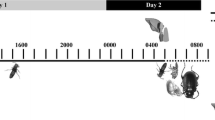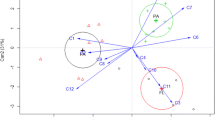Abstract
Male Euglossini bees (Apidae) forage for floral and non-floral perfumes. Although the use of these perfumes has not yet been clearly reported, there are indications of using perfume from varied exogenous sources as a pheromone analogue since male orchid bees do not produce it. Here, we report an interaction between male Euglossa annectans and flowers of Angelonia salicariifolia (Plantaginaceae). Floral anatomy analysis and a histological study of two different sets of trichomes indicate the presence of aromatic oils (perfume) in one set of these trichomes. The other set of trichomes produce resins. Both sets of trichomes are found in the same floral area of the flower where the male orchid bees were seen. The male orchid bees studied forage for perfumes but do not promote pollination since they do not reach the reproductive structures during their visit. Our records show that only male E. annectans were attracted to the volatile fragrance although we know that other orchid bee species also occur in the area.



Similar content being viewed by others
References
Armbuster, W.S., Webster, G.L. (1979) Pollination of two species of Dalechampia (Euphorbiaceae) in Mexico by euglossine bees. Biotropica 11, 278–283
Buchanan, B.B., Gruissem, W., Jones, R.L. (2000) Biochemistry and molecular biology of plants. American Society of Plant Physiologists, Rockville
Buchmann, S. (1987) The ecology of oil flowers and their bees. Annu Rev Ecol Syst 18, 343–369
Cain, A.J. (1947) The use of Nile blue in the examination of lipoids. Q J Microsc Sci 88, 383–392
Cappellari, S.C., Harter-Marques, B. (2010) First report of scent collection by male orchid bees (Hymenoptera: Apidae: Euglossini) from terrestrial mushrooms. J Kansas Entomol Soc 83, 264–266
Cappellari, S.C., Harter-Marques, B., Aumeier, P., Engels, W. (2009) Mercadomia tenella (Plantaginaceae) attracts oil-, perfume-, and pollen-gathering bees in Southern Brazil. Biotropica 41, 721–729
Cappellari, S.C., Haleem, M.A., Marsaioli, A.J., Tidon, R., Simpson, B.B. (2011) Pterandra pyroidea: a case of pollination shift within Neotropical Malighiaceae. Ann Bot-London 107, 1323–1334
Carvalho Filho, F.S. (2010) Scent-robbing and fighting among male orchid bees, Eulaema (Apeulaema) nigrita Lepeletier, 1841 (Hymenoptera: Apidae: Euglossini). Biota Neotrop 10, 405–408
Carvalho, R., Webber, A.C. (2000) Biologia floral de Unonopsis guatterioides (A.D.C.) R.E. Fr., uma Annonaceae polinizada por Euglossini. Revta bras Bot 23, 421–425
Cordeiro, G.D., Boff, S., Caetano, T.A., Fernandes, P.C., Alves dos Santos, I. (2013) Euglossine bees (Apidae) in Atlantic forest areas of São Paulo State, southeastern Brazil. Apidologie 44, 254–267
David, R., Carde, J.P. (1964) Coloration différentielle des inclusions lipidique et terpeniques des pseudophylles du Pin maritime au moyen du reactif Nadi. C R Acad Sci (Paris) 258, 1338–1340
Dodson, C.H., Dressler, R.L., Hills, H.G., Adams, R.M., Williams, N.H. (1969) Biologically active compounds in orchid fragrances. Science 164, 1243–1249
Dressler, R.L. (1982) Biology of the orchid bees (Euglossini). Annu Rev Ecol Syst 13, 373–394
Eltz, T., Roubik, D.W., Lunau, K. (2005a) Experience-dependent choices ensure species-specific fragrance accumulation in male orchid bee. Behav Ecol Sociobiol 59, 129–156
Eltz, T., Sager, A., Lunau, K. (2005b) Juggling with volatiles: exposure of perfumes by displaying male orchid bees. J Comp Physiol 191, 575–581
Eltz, T., Zimmermann, Y., Pfeiffer, C., Ramírez Pech, J., Twele, R., Francke, W., Quezada-Euan, J.J.G., Lunau, K. (2008) An olfactory shift is associated with male perfume differentiation and species divergence in orchid bees. Curr Biol 18, 1844–1848
Faegri, K., van der Pijl, L. (1979) The principles of pollination ecology, 3rd revised edition. Pergamon Press, Oxford
Furr, M., Mahlberg, P.G. (1981) Histochemical analyses of laticifers and glandular trichomes in Cannabis sativa. J Nat Prod 44, 153–159
Ganter, P., Jollés, G. (1969) Histologie normale et pathologique, vol. 1. Gauthier-Villars, Paris
Ganter, P., Jollés, G. (1970) Histologie normale et pathologique, vol. 2. Gauthier-Villars, Paris
Gregory, M., Baas, P. (1989) A survey of mucilage cells in vegetative organs of the dicotyledons. Isr J Bot 38, 125–174
Jensen, W.A. (1962) Botanical histochemistry: principles and practice. Freeman, San Francisco
Johansen, D.A. (1940) Plant microtechnique. McGraw-Hill, New York
Kirk Jr., P.W. (1970) Neutral red as a lipid fluorochrome. Stain Technol 45, 1–4
Langenheim, J.H. (2003) Plant resins: chemistry, evolution, ecology, and ethnobotany. Timber Press, Cambridge
Machado, I.C., Vogel, S., Lopes, A.V. (2002) Pollination of Angelonia cornigera Hook. (Scrophulariaceae) by long-legged, oil collecting bees in NE Brazil. Plant Biol 4, 352–359
Martins, A.C., Aguiar, A.J.C., Alves dos Santos, I. (2013) Interaction between oil-collecting bees and seven species of Plantaginaceae. Flora 208, 401–411
Matozzo, V.C., Faria, L.R.R., Melo, G.A.R. (2011) Orchid bees (Hymenoptera: Apidae) in the coastal forest of southern Brazil: diversity, efficiency of sampling methods and comparison with other Atlantic forest surveys. Pap Avulsos Zool 51, 505–515
Pearse, A.G.E. (1985) Histochemistry: theoretical and applied, vol. 2. 4th ed. C. Livingstone, Edinburgh
Pearson, D.L., Dressler, R.L. (1985) Two-year study of male orchid bee (Hymenoptera: Apidae: Euglossini) attraction to chemical baits in lowland southeastern Peru. J Trop Ecol 1, 37–54
Pemberton, R.W., Wheeler, G.S. (2006) Orchid bees don’t need orchids: evidence from the naturalization of an orchid bee in Florida. Ecology 87, 1995–2001
Peter, C.I., Johnson, S.D. (2014) A pollinator shift explains floral divergence in an orchid species complex in South Africa. Ann Bot-London 113, 277–288
Pokorny, T., Hannibal, M., Quezada-Euan, J.J.G., Hedenström, E., Sjöberg, N., Bång, J., Eltz, T. (2013) Acquisition of species-specific perfume blends: influence of habitat-dependent compound availability on odour choices of male orchid bees (Euglossa spp.). Oecologia 172, 417–425
Ramírez, S., Dressler, R.L., Opsina, M. (2002) Abejas euglossinas (Hymenoptera:Apidae) de la Región Neotropical: Listado de espeices con notea sobre su biología. Biot Colomb 3, 7–118
Ramírez, S., Eltz, T., Fujiwara, M.K., Gerlach, G., Goldman-Huertas, B., Tsutsui, N.D., Pierce, N.E. (2011) Asynchronous diversification in a specialized plant-pollinator mutualism. Science 333, 1742–1746
Rebêlo, J.M.M., Garófalo, C.A. (1991) Diversidade e sazonalidade de machos de Euglossini (Hymenoptera, Apidae) e preferências por iscasodores em um fragmento de floresta no sudeste do Brasil. Rev Bras Biol 51, 787–799
Rosas-Guerrero, V., Aguilar, R., Martén-Rodríguez, S., Ashworth, L., Lopezaraiza-Mikel, M., Bastida, J.M., Quesada, M. (2014) A quantative review of pollination syndrome: do floral traits predict effective pollinators? Ecol Lett 17, 388–400
Roubik, D.W., Hanson, P.E. (2004) Abejas de orquídeas de a América tropical: biologia y guia de campo. Orchid bees of tropical America: biology and field guide, San José
Sazima, M., Vogel, S., Cocucci, A., Hausner, G. (1993) The perfume flowers of Cyphomandra (Solanaceae): pollination by euglossine bees, bellows mechanism, osmophores, and volatiles. Plant Syst Evol 187, 51–88
Smith, S.D., Ané, C., Baum, D.A. (2009) Macroevolutionary tests of pollination syndromes: a reply to Fenster et al. Evolution 63, 2763–2767
Vogel, S. (1966) Parfümsammelnde Bienen als Bestäuber von Orchidaceen und Gloxinia Osterr. Bot Zs 113, 302–361
Vogel, S. (1974) Ölblumen und ölsammelnde Bienen. Trop Subtrop Pflanzenwelt 7, 1–267
Vogel, S. (1990) The role of scent glands in pollination. Amerind Publishing, New Delhi
Vogel, S., Machado, I.C. (1991) Pollination of four sympatric species of Angelonia (Scrophulariaceae) by oil-collecting bees in NE Brazil. Plant Syst Evol 178, 153–178
Waser, N.M., Chittka, L., Price, M.V., Williams, N.M., Ollerton, J. (1996) Generalization in pollination systems, and why it matters. Ecology 77, 1043–1060
Whitten, W.M., Young, A.M., Stern, D.L. (1993) Non-floral sources of chemicals that attract male euglossine bees (Apidae: Euglossini). J Chem Ecol 19, 3017–3027
Williams, N.H., Dressler, R.L. (1976) Euglossine pollination of Spathiphyllum (Araceae). Selbyana 1, 349–356
Williams, N.H., Whitten, W.M. (1983) Orchid floral fragrances and male Euglossine bees: methods advances in the last sesquidecade. Biol Bull 164, 355–395
Acknowledgments
We thank Claudia Saito and Sheina Koffler for their help and additional observations in the field, Paulo César Fernandes for providing pictures and Antonella Soro and the two reviewers for helpful comments. Coordenação de Aperfeiçoamento de Pessoal de Nível Superior (CAPES) funded the first author.
Author information
Authors and Affiliations
Corresponding author
Additional information
Handling Editor: Bernd Grünewald
La production de parfum dans les fleurs d’ Angelonia salicariifolia attire les mâles d’ Euglossa annectans bien qu’ils ne participent pas à la pollinisation
Euglossini / analyse histochimique / voleur de parfum / trichomes / parfum volatile
Duftproduktion in Blüten von Angelonia salicariifolia wirken anziehend auf Männchen von Euglossa annectans , die nicht als Bestäuber fungieren
Euglossa annectans / Euglossini / histochemische Analyse / Duft Räuber / Trichom / flüchtige Duftstoffe
Rights and permissions
About this article
Cite this article
Boff, S., Demarco, D., Marchi, P. et al. Perfume production in flowers of Angelonia salicariifolia attracts males of Euglossa annectans which do not promote pollination. Apidologie 46, 84–91 (2015). https://doi.org/10.1007/s13592-014-0305-2
Received:
Revised:
Accepted:
Published:
Issue Date:
DOI: https://doi.org/10.1007/s13592-014-0305-2




